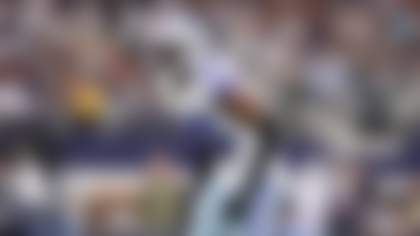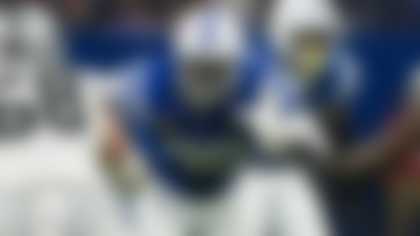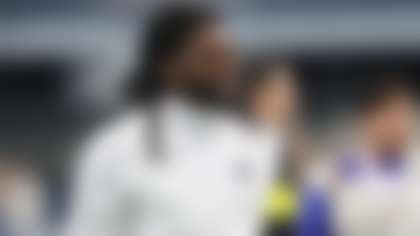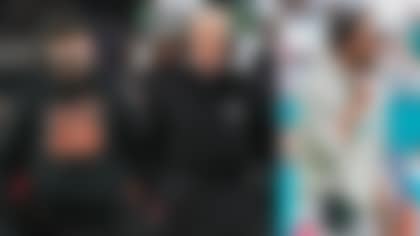In his robust Inside The NFL Notebook below, NFL Network's Albert Breer touches on multiple topics, including (click on each link to take you directly to the topic):
» Four things he's looking forward to in Week 13.
» The incident in Week 12 that encapsulated one team's season.
» One coaching change to keep a close eye on.
» And much more, beginning with a league-wide trend that is creating some major issues ...
It was Aaron Rodgers who took a beating on Sunday, absorbing five sacks in the New York Giants' 38-10 beatdown of the Green Bay Packers.
Fifteen days ago, Ben Roethlisberger took a kill shot, almost literally, from the Kansas City Chiefs. The day before that, Alex Smith, Jay Cutler and Michael Vick were concussed.
And outside of Smith, who was running the ball when he took his hit, all of these quarterbacks have something in common with a surprising number of recent champions and contenders: offensive line issues.
Gone are the days of the dominating lines of the 1990s Dallas Cowboys, the '80s San Francisco 49ers, or the transcendent Hogs in Washington. Prime contenders in New York (the Giants), Philadelphia, Chicago, Green Bay, Atlanta, New England, Baltimore and Pittsburgh entered the season with questions along their offensive lines. Only New England and Atlanta have sufficiently answered those, yet Philly is the only member of this group that isn't in the thick of the playoff race.
So the evidence shows that having a good line simply doesn't mean as much as it used to.
"I think you can mask (problems) up there," an AFC scouting director said. "You definitely can. The perfect example is the Steelers. At times, it doesn't look right at all. At other times, they're blowing everyone off the ball. The constant is the guys taking the snaps. And there was no greater example than Indy last year."
The Indianapolis Colts built a line, during the Peyton Manning years, that was anchored by Tarik Glenn and Jeff Saturday. But as time went by, the team started to invest in its skill players on offense, Glenn retired, Saturday got old, and the pieces around them didn't get better.
Indianapolis kept scoring points, and kept sack numbers low, but as the 2011 season showed us, that was simply a function of how adept Manning was at managing the problem.
"[The offensive line] was below average most of the years [Manning] was there," an AFC scout said. "By the end, it'd qualify as poor. For a lot of those years, they didn't spend a high-round pick there -- I think (2007 second-rounder Tony) Ugoh was their highest pick. For the most part, they didn't see the reason to put a premium on it. I don't blame them. The average fan is gonna say, 'You have a great quarterback, you gotta protect him.' But the truth is, the great ones don't need it."
Three of the Giants' five linemen are homegrown -- two second-round picks and a fifth-round pick. The Packers' starters on Sunday night? A fifth-round pick, two fourth-round picks, an undrafted free agent and Saturday, cast off by Indy. The Bears just benched the only lineman they picked in the top 100 (Gabe Carimi). The Steelers, meanwhile, started three different left tackles in their three Super Bowl appearances over the past decade and only recently began spending high picks to protect Big Ben.
And yet, all four of those teams are contenders.
No coincidence that all four have big-time quarterbacks, either. As the aforementioned scout intimated, while logic holds that it's wise to bubble-wrap the franchise with pedigreed linemen, so often, the opposite has been true. An elite quarterback gives teams leeway to cut corners at those positions. One example cited was the case of Steve Sciullo, who was a full-time starter in front of Manning in 2003 and out of the NFL completely by 2005.
"There were periods where (the Colts) had personnel -- Glenn and Saturday were good starters," an AFC executive said. "But as time went on, they made the conscious decision to allocate resources to the skill positions, with (Reggie) Wayne and (Marvin) Harrison and (Dallas) Clark, and the pass rushers. And there came a point with them where it was all smoke and mirrors up front."
Manning and Tom Brady are able to play the lead in this kind of magic act by setting protection correctly and unloading the ball swiftly. Roethlisberger and Rodgers can extend plays and elude the first wave of rushers, buying their linemen some margin for error.
But it doesn't work for everyone. The AFC exec emphasized that it's a matter of scheme. Zone-heavy offenses, and clubs that base their running game off their pass game, can get by with some spare parts.
Others can't. The 49ers, for example, have three first-round picks on their line, a necessity for their downhill run game.
"The Colts never had a downhill run game with Manning," the AFC exec said. "The run game was the benefactor of the pass offense. The Niners, on the other hand, can push people off the line and go downhill, and that makes things easier on everyone else, including the quarterback. You need linemen to do that. And if you're rebuilding and you don't have the quarterback, that's the way to go -- build from the inside out."
The AFC exec continued that he felt most teams should invest in one tackle and one interior lineman. The structure of the rest of the line is based on the setup of the offense.
Harrison: Week 13 Power Rankings
Twenty-six of the NFL's 32 teams are on the move -- some up, some down -- in Elliot Harrison's updated pecking order. **More ...**
But for everyone, there are challenges. Because it's the largest position group -- with five starters -- there's no way to keep a good young line completely intact long-term. At some point, decisions on who to pay, and who not to pay, will arise.
And that's when the offensive line coach becomes key. This assistant must be able to both blend players together in a spot that demands cohesion and also develop young guys in an age when personnel folks are often taught that draft capital need not be spent on the O-line. As the AFC scout said, "The philosophy I was brought in with was that, with the exception of the left tackle, we don't want to take linemen in the first three or four rounds."
So having someone like New England's Dante Scarnecchia, who was once resourceful enough to develop college wrestler Stephen Neal into a bedrock guard, can be huge. In fact, that ability to adapt and adjust up front has almost become a requirement in the salary-capped NFL.
And if you need a reminder on the cost of failure here, the recent rash of quarterback injuries certainly can provide that.
Four things I'll be watching in Week 13
1) The Steelers-Ravens Survival Bowl. There's always every reason to watch this one, which, as Ravens coach John Harbaugh told me last year, takes football "into this dark place." But what's really intriguing this year is that both teams are fighting against attrition, in addition to one another. The Steelers have fought through a slew of significant injuries this fall (Ben Roethlisberger, Antonio Brown, James Harrison, Troy Polamalu), as have the Ravens (Terrell Suggs, Ray Lewis, Lardarius Webb). And both have a chance to get healthier, and right, before January, which makes each of these battled-tested teams dangerous. Another significant piece of news to that end emerged this week, with Yahoo! Sports reporting Lewis could be back in mid-December. I spoke with Harbaugh about that after the story surfaced on Monday, and he said, "It's hard for me to know what it all really means -- all these guys do these intensive rehab things, and sometimes it works and sometimes it doesn't. My understanding is it's a question mark, but a possibility. And he's optimistic, so I'm optimistic." With players like Lewis and Roethlisberger on the mend, there's reason for optimism for both teams in this Week 13 bout.
2) The reality of where the Miami Dolphins stand. Dolphins general manager Jeff Ireland and coach Joe Philbin have stabilized the franchise after a very chaotic 2011. And Sunday was the perfect example of the change: The team was backsliding and on a three-game losing streak, yet Miami found a way to stop the bleeding against a very good opponent. Now, the Seattle Seahawks haven't been great on the road, but prior to Sunday, the biggest reason for that was rookie quarterback Russell Wilson's struggles away from CenturyLink Field. Against Miami, though, Wilson played very well. Consequently, the Dolphins simply beat Seattle strength-on-strength, running for 189 yards at a 6.8-per-carry clip while holding the Seahawks to 96 yards and a 3.6-yard average. On top of that, Ryan Tannehill was efficient (18-for-26, 253 yards, TD, INT) despite facing the fearsome pass rush of Pete Carroll's top-shelf defense. What's next? A progress report for the Dolphins, facing the team in New England that they've been chasing for a decade in the AFC East.
Breer: A position of strength
Colin Kaepernick is the latest to benefit from 49ers coach Jim Harbaugh's knack for nurturing QBs, Albert Breer says. **More ...**
3) Colin Kaepernick's progress. New Orleans Saints interim coach Joe Vitt said on Monday that the Niners' precocious starter caught his defense a little off-guard with his foot speed. Defensive coordinator Steve Spagnuolo said he wasn't surprised by it, but dealing with it is different from planning for it. So yes, the Niners are more dynamic with Kaepernick in there. As time progresses, though, the surprises will melt away, and that means Kaepernick will have to be able to counterpunch, which is a challenge for any young quarterback. Now, some have compared this transition to the Patriots turning to Tom Brady in 2001, and there's some merit to the idea. But let's remember, back then, Brady wasn't what he is now. While he was incredibly clutch, Brady led just two touchdown drives in that year's playoffs -- the team scored touchdowns on defense and special teams during that run -- and the club's opponents were held to a total of 47 points in three games. But the most valid reason for the comparison is that the Niners -- like the 2001 Patriots -- are championship worthy. And if the Patriots had to prop up Brady back then, you had better believe San Francisco will have moments when it'll have to prop up Kaepernick. There's the risk in Jim Harbaugh's bold decision. If Kaepernick hits one of those inevitable bumps on the wrong day, can the rest of the team carry him through? This much we know: With each week, opponents will learn more, and there will be new challenges for Kaepernick.
4) Robert Griffin III. The Washington Redskins quarterback is at the point where he's must-see TV every week, but this week does present something fresh and different for the rookie. Five weeks ago in this space, we mentioned how playing an NFC East opponent (the New York Giants) for the first time would present a new dynamic for Griffin. He aced that test, despite falling short on the scoreboard, throwing for 258 yards on 20-of-28 passing (compiling a 108.9 passer rating) and rushing for 89 yards on nine carries. RG3 gets the Giants again on Monday night, this time on his turf and in prime time, and it'll mark the first time a defense has gotten a second shot at him. For their part, the Giants know what they're up against. Justin Tuck told the New York press on Monday, "I don't plan on being here (for another decade), but until I exit stage right, it seems like he's going to be a fixture in my dreams. And nightmares." The main thing the champs said they took away from the first meeting is that being disciplined is paramount -- in tackling, in rushing and in coverage. That's great and all. More interesting will be how Giants defensive coordinator Perry Fewell uses scheme to clean up some of the mistakes Griffin burned them on in October.
Three conclusions
1) Jim Schwartz's challenge-flag throw was sadly emblematic. Matt Stafford summed up the Detroit Lions' problems to me like this last week: "It's not one thing. It's little mistakes here and there; it's been tight games where we just didn't come out on the right end." Center Dominic Raiola said the team isn't where it needs to be mentally, and that "we're not making the plays we made last year. Look at the tipped balls, the drops, the pick-sixes -- last year, we were making those plays." So what does the coach's ill-timed toss have to do with this? It seems to encapsulate a lost year that started with a slew of off-field problems, and has been marked in-season by sloppy play. Discipline and detail show up in the big spots, and that's where the Lions simply don't seem to have it this time around. The good news is, a problem like that is correctable. And Schwartz is a smart young coach who sees things analytically and is eminently capable of finding a fix. He apologized the other day for costing his team in this instance. The larger problems will likely need an offseason to be amended, and that offseason probably won't be the most pleasant one for the players.
2) The Saints' wherewithal is impressive. And that's even considering the fact that they didn't win Sunday. Over the summer, and before having to leave the team for his own suspension, interim coach Joe Vitt delivered this message to his players: "Look, there are a million excuses to get out of anything that happens this year, and they're there for the taking. If you want outs, we have outs. You can tell everyone we don't have coach, we don't have Joe (Vitt), (Jonathan) Vilma's not here; there's a million excuses. But at the end of the day, excuses aren't going to help anybody." Several players told me the message was similar to one Sean Payton delivered in 2007 when that version of the team got off to a rough start. This one helped them focus through another horrific beginning, which followed all they'd been through as part of the bounty scandal. Drew Brees had a hiccup against the Niners, but that was preceded by a three-game tear. The defense is getting better. And my sense is that New Orleans will be in this thing to the end.
Week 13 Waiver Wire
Michael Fabiano lists the top waiver wire targets for fantasy owners in Week 13. More ...
3) More can be done to deter PED use. This week, it was Richard Sherman, Brandon Browner and Jermaine Cunningham. Next week, there could be more. And as has been the case in the majority of these situations, Adderall is the drug all three players blamed for producing the positive test. I'm not saying that's not true. But I do know others have lied publicly about it. Two weeks ago, Falcons offensive lineman Joe Hawley was caught, and when he sent out a statement about the test being for Adderall, he did it through the NFL Players Association. Part of the reason the union did that for him is that he was telling the truth, and he didn't want suspicion out there that he was skirting the facts. Fact is, Adderall is used most commonly a) to treat attention deficit hyperactivity disorder (ADHD) and b) as a party drug. It doesn't carry the stigma steroids do. So for players, saying they got busted for Adderall is the new version of the old "I didn't know what GNC sold me" excuse. The solution here in creating a stronger reason for players to stop would be a tough one for the league and union to swallow: full disclosure.
Two college players to watch on Saturday
1) Georgia OLB Jarvis Jones (vs. Alabama, 4 p.m. ET, CBS): On the field, Jones is one of the country's most productive players, and as a 3-4 outside linebacker, he won't need to be projected to the spot he figures to play as a pro. Trouble is, he's just 6-foot-3, he's narrow and he might not be all that fast, which has some in the scouting community doubting he's the top-overall pick-type others have projected him to be. "He's had a lot of production, but he's one of those guys where the sum is greater than the parts," said a college scouting director. "This will be a great opportunity for him to show his ability against a big, stout O-line." As has been said ad nauseum in this spot before, if a prospect played against Alabama as a collegian, it's the first tape that's playing for NFL talent evaluators. So based on his perceived physical limitations, Jones could either be validated or exposed this weekend.
2) West Virginia WR Tavon Austin (vs. Kansas, 2:30 p.m. ET, Fox Sport Network): Probably the most electric player in college football, Austin's problem isn't hard to figure. He's listed at 5-9 and 171 pounds, and chances are he's even smaller than that. That said, one evaluator called Austin a "smaller Percy Harvin." Another college scout said, "He's a niche-type player -- you look at players like him, it's probably a little bit like a (Dexter) McCluster, that 'tweener type. Is he a receiver? Is he a tailback? How do you use him? Here's how: You find a way. He's a package guy, though, and you take him knowing you have to design things for him. Most college offenses have that guy; doesn't fit a position, but he's such a special athlete." Size probably keeps him out of Round 1, but he's an intriguing prospect for just about everyone.
One prediction
The Tennessee Titans will improve with the coaching staff shakeup. Offensive coordinator Chris Palmer's ouster had been coming for a few weeks now, with those inside the organization losing faith in his ability to be creative in general and sharp enough on game day in particular.
To a large degree, the run game has been fixed, with Chris Johnson compiling an eye-popping 641 yards over his past five games. What's needed is for the coaches to find a way to get Jake Locker into a better rhythm, and highly regarded quarterbacks coach Dowell Loggains will get the call in Palmer's place.
Loggains started in the league under Sean Payton, is seen as a rising star in the profession and has as good a feel for Locker as anyone in the building. So my educated guess is that this was the right move by head coach Mike Munchak, whose team is trying to dig out of a 4-7 hole.
Follow Albert Breer on Twitter @AlbertBreer.



